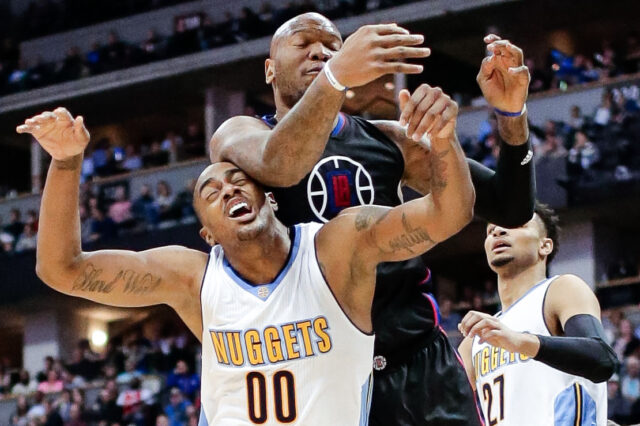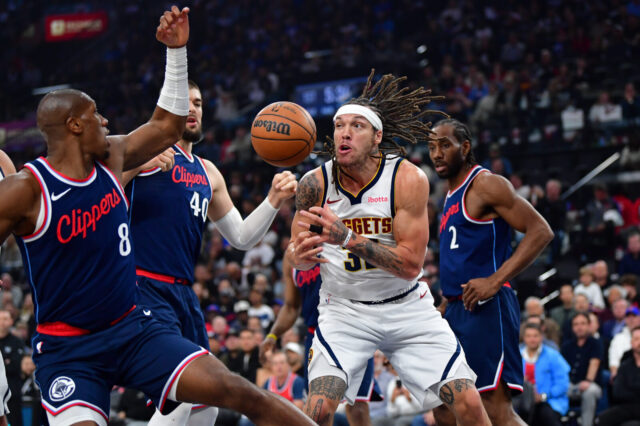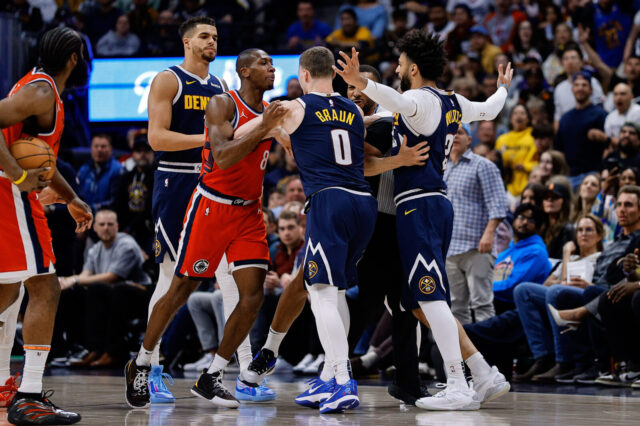This edition of Stat of the Week will focus on the Nuggets offense. I have a variety of theories on why the team has struggled so much to become a cohesive unit, but instead of going into those, I will merely present the numbers. There are a lot of numbers that tell various sides of the story, but for now, I will focus on two factors: shot location and player shot volume.
Overview
To put the Nuggets offensive struggles in perspective, the team generated a 110.0 offensive rating in 2016-17. That means they scored 110 points per 100 possessions over the course of the entire year. Before December 15th, when Nikola Jokic was made the focal point of the offense, the team had a 102.7 offensive rating. After December 15th, the team had a 113.3 offensive rating, tops in the entire NBA during those four months.
Fast forward to this season, and the Nuggets, after adding Paul Millsap, are reeling offensively. Through four games, the offensive rating is a measly 98.3, 23rd in the NBA. That would be fine if their defense was an elite unit, but it’s not. At a 104.3 defensive rating and 17th in the NBA, Denver has two below average units. The last time that happened, they went 33-49 in 2015-16.
With expectations as high as they are this year, the Nuggets have been disappointing through four games. While one must remember that four games composes less than 5% of the entire season, these are games that will matter in the standings at the end of the year.
As I alluded to earlier, the two biggest problems in my mind are shot location and shot distribution among players.
Shot Location
Ben Falk, former VP of Basketball Strategy with the Philadelphia 76ers and Analytics Manager with the Portland Trail Blazers was recently on ESPN writer Zach Lowe’s podcast to discuss the NBA, including his new website: Cleaning the Glass. This excellent statistical site provides an intriguing look at team performance, player performance, various articles, and a database full of useful information.
One of his most interesting tools involves comparing the shot distribution of teams to their previous iterations. From year-to-year, the frequency of field goal attempts at the rim, in the midrange spots, and behind the three-point line are tracked by team. For the Nuggets, a team heavily emphasizing rim attacks throughout their history and three point attempts last year, the numbers through the first four games are striking.
This content is no longer available.
Last season, the Nuggets attacked the rim with ferocity, and for a facilitator like Jokic, it created open shooters that he found without difficulty. This year, the percentage of attempts at the rim has dropped magnificently from third best to second worst in the entire NBA.
Granted, the Nuggets have faced some of the best rim protectors in the NBA so far in Rudy Gobert and Dwight Howard, but these problems run deeper. In my estimation, there are three general ways to create shots at the rim in the half court today:
- A pick and roll ball-handler that can create separation off the dribble.
- A pick and roll roll-man that drags the defense into the paint and creates open lanes.
- A passing big man and an open lane to generate back cuts.
Only two players on the Nuggets roster have the innate ability to be option #1: Emmanuel Mudiay and Will Barton. Mudiay is currently averaging 2.0 assists per game, and his struggles finishing around the rim have not subsided. Barton is averaging 3.5 assists per game, and while he’s been better, it hasn’t been game changing.
The two guards in Denver’s starting lineup, Jamal Murray and Gary Harris, have struggled handling pick and roll duties as well. Murray is a solid scorer, but he hasn’t found the range on his drives yet, and shot blockers have really affected him (not surprising for a 20-year-old). Harris needs to take a step forward as a dribble creator to mitigate this issue, but so far, that doesn’t look like it’s a part of Harris’ repertoire.
Jokic is Denver’s best roll-man, followed closely by Kenneth Faried. Last year, Jokic and Faried scored 1.15 points per possession as roll-men, but this year, that number is down to 1.00 for both. Some of this has to do with the new spacing of Paul Millsap and Wilson Chandler at the forwards for Jokic. Faried is simply playing less, and his gravity is missed on offense. Both players have to finish better in their opportunities as well.
That leaves cutting to the basket, but so far, Denver has had limited cuts. Harris has just four scoring possessions on cuts. Murray has just one. Chandler has two. Millsap has two. Plumlee leads the team with eight cuts, which makes up over 25% of his offense (he knows his limitations), but that’s still an issue. Last year, cutting frequency was up across the board. It’s what made Denver such a difficult team to guard in the half court. They kept defense honest.
More drives, rolls, and cuts to the rim obviously increase shots at the rim. They also increase three-point frequency though. Collapsing the defense onto players in the paint opens up players on the perimeter. While Denver may not be a top 3 team in shots at the rim this year, they cannot finish 29th like they are right now. Because the Nuggets don’t have a number of elite three point shooters like the Golden State Warriors, they must compensate by attacking the front of the rim.
Shot Distribution
This section will be shorter, as it merely will relay that the best player on the Nuggets, Jokic, is also taking shots with close to the lowest frequency.
| Player | FGA/game | Team Rank | Usage Rate | Team Rank |
|---|---|---|---|---|
| Emmanuel Mudiay | 9.0 | 6 | 26.7 | 1 |
| Paul Millsap | 12.5 | 2 | 23.9 | 2 |
| Jamal Murray | 11.8 | 3 | 23.2 | 3 |
| Mason Plumlee | 5.0 | 8 | 22.0 | 4 |
| Will Barton | 13.0 | 1 | 21.4 | 5 |
| Trey Lyles | 1.3 | 10 | 20.2 | 6 |
| Kenneth Faried | 3.5 | 9 | 19.7 | 7 |
| Nikola Jokic | 9.5 | 5 | 18.9 | 8 |
| Gary Harris | 10.3 | 4 | 17.7 | 9 |
| Wilson Chandler | 8.3 | 7 | 13.9 | 10 |
| Malik Beasley | 1.3 | 10 | 9.3 | 11 |
| Juancho Hernangomez | 0.5 | 12 | 3.7 | 12 |
Jokic currently averages 9.5 shots a night. Some of that is his own doing, as he has taken on extra playmaking responsibility and currently leads the team with 5.0 assists per contest. Still, 9.5 shots for a center of Jokic’s caliber offensively is a travesty of offensive play calling. Whether it’s Jokic’s doing or not, it needs to stop. It’s clearly not helping the team for others to be taking those shots.
Last season, Jokic’s usage rate settled in at 25.2% after December 15th. Before December 15th? 18.3%. That is shockingly close to Jokic’s current 18.9%.
Other tidbits to take away from here:
- Mudiay should not be outpacing Barton in usage rate off the bench. Barton is Denver’s best scorer, and while Mudiay has a knack to get to the rim, that skill would best be used setting the table for others on the second unit rather than his own attempts at the rim. With Barton, Malik Beasley, and other shooters likely to surround bench units at this point, Mudiay should have plenty of targets on the perimeter, as well as a roll man in Mason Plumlee also willing to assist.
- Jamal Murray’s true shooting percentage is 34.9%, which includes his perfect free throw percentage. If that doesn’t go up, he can’t stay in the starting unit. End of story.
- Gary Harris has to be more involved on a game to game basis. He has a tendency to disappear, and when he does, the spacing on the floor becomes cramped. Whether Harris is driving to the rim or spacing the floor from the three-point line, aggressive Gary Harris makes the Denver Nuggets a better team.
- Trey Lyles needs an opportunity to prove himself. He’s the one front court player that Denver hasn’t tried during the regular season to figure out if he can smooth out the rotation. Chandler may end up becoming the backup power forward, but until that happens, Denver can’t continue to experiment with such a weird front court rotation off the bench because Faried and Plumlee cannot play together. Lyles can space the floor and provide instant offense on a unit that may need it. In order to keep the rotations less complicated, inserting Lyles may not be a bad idea.
That does it or Stat of the Week. Let me know what I should tackle for next week in the comments or on Twitter.


